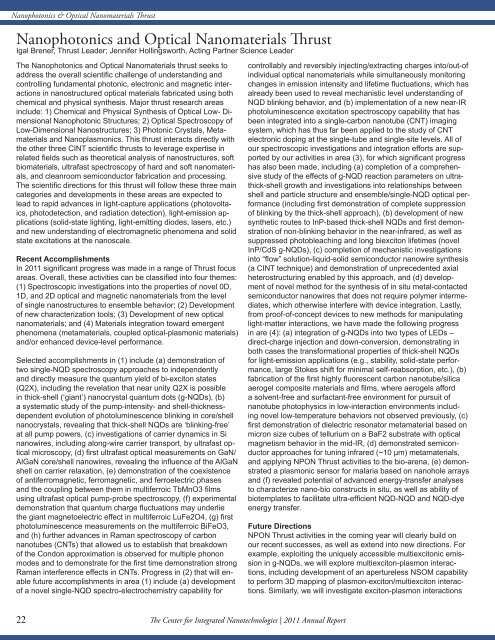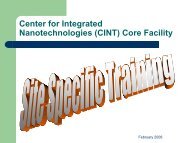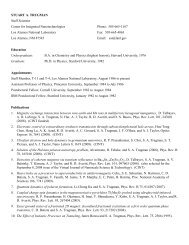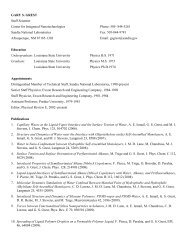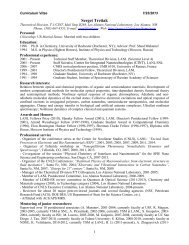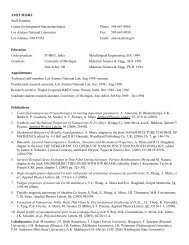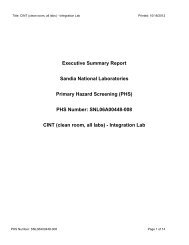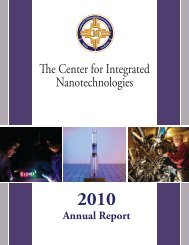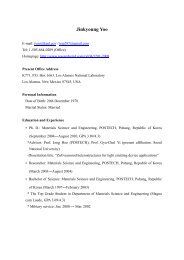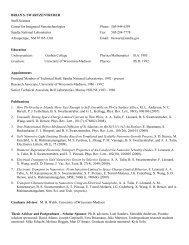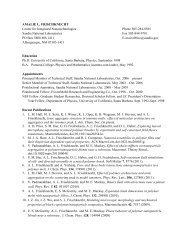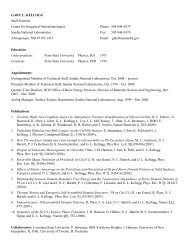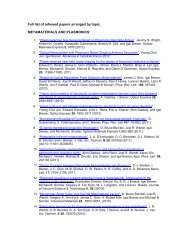2011 Annual Report - Center for Integrated Nanotechnologies - Los ...
2011 Annual Report - Center for Integrated Nanotechnologies - Los ...
2011 Annual Report - Center for Integrated Nanotechnologies - Los ...
You also want an ePaper? Increase the reach of your titles
YUMPU automatically turns print PDFs into web optimized ePapers that Google loves.
Nanophotonics & Optical Nanomaterials Thrust<br />
Nanophotonics and Optical Nanomaterials Thrust<br />
Igal Brener, Thrust Leader; Jennifer Hollingsworth, Acting Partner Science Leader<br />
The Nanophotonics and Optical Nanomaterials thrust seeks to<br />
address the overall scientific challenge of understanding and<br />
controlling fundamental photonic, electronic and magnetic interactions<br />
in nanostructured optical materials fabricated using both<br />
chemical and physical synthesis. Major thrust research areas<br />
include: 1) Chemical and Physical Synthesis of Optical Low- Dimensional<br />
Nanophotonic Structures; 2) Optical Spectroscopy of<br />
Low-Dimensional Nanostructures; 3) Photonic Crystals, Metamaterials<br />
and Nanoplasmonics. This thrust interacts directly with<br />
the other three CINT scientific thrusts to leverage expertise in<br />
related fields such as theoretical analysis of nanostructures, soft<br />
biomaterials, ultrafast spectroscopy of hard and soft nanomaterials,<br />
and cleanroom semiconductor fabrication and processing.<br />
The scientific directions <strong>for</strong> this thrust will follow these three main<br />
categories and developments in these areas are expected to<br />
lead to rapid advances in light-capture applications (photovoltaics,<br />
photodetection, and radiation detection), light-emission applications<br />
(solid-state lighting, light-emitting diodes, lasers, etc.)<br />
and new understanding of electromagnetic phenomena and solid<br />
state excitations at the nanoscale.<br />
Recent Accomplishments<br />
In <strong>2011</strong> significant progress was made in a range of Thrust focus<br />
areas. Overall, these activities can be classified into four themes:<br />
(1) Spectroscopic investigations into the properties of novel 0D,<br />
1D, and 2D optical and magnetic nanomaterials from the level<br />
of single nanostructures to ensemble behavior; (2) Development<br />
of new characterization tools; (3) Development of new optical<br />
nanomaterials; and (4) Materials integration toward emergent<br />
phenomena (metamaterials, coupled optical-plasmonic materials)<br />
and/or enhanced device-level per<strong>for</strong>mance.<br />
Selected accomplishments in (1) include (a) demonstration of<br />
two single-NQD spectroscopy approaches to independently<br />
and directly measure the quantum yield of bi-exciton states<br />
(Q2X), including the revelation that near unity Q2X is possible<br />
in thick-shell (‘giant’) nanocrystal quantum dots (g-NQDs), (b)<br />
a systematic study of the pump-intensity- and shell-thicknessdependent<br />
evolution of photoluminescence blinking in core/shell<br />
nanocrystals, revealing that thick-shell NQDs are ‘blinking-free’<br />
at all pump powers, (c) investigations of carrier dynamics in Si<br />
nanowires, including along-wire carrier transport, by ultrafast optical<br />
microscopy, (d) first ultrafast optical measurements on GaN/<br />
AlGaN core/shell nanowires, revealing the influence of the AlGaN<br />
shell on carrier relaxation, (e) demonstration of the coexistence<br />
of antiferromagnetic, ferromagnetic, and ferroelectric phases<br />
and the coupling between them in multiferroic TbMnO3 films<br />
using ultrafast optical pump-probe spectroscopy, (f) experimental<br />
demonstration that quantum charge fluctuations may underlie<br />
the giant magnetoelectric effect in multiferroic LuFe2O4, (g) first<br />
photoluminescence measurements on the multiferroic BiFeO3,<br />
and (h) further advances in Raman spectroscopy of carbon<br />
nanotubes (CNTs) that allowed us to establish that breakdown<br />
of the Condon approximation is observed <strong>for</strong> multiple phonon<br />
modes and to demonstrate <strong>for</strong> the first time demonstration strong<br />
Raman interference effects in CNTs. Progress in (2) that will enable<br />
future accomplishments in area (1) include (a) development<br />
of a novel single-NQD spectro-electrochemistry capability <strong>for</strong><br />
controllably and reversibly injecting/extracting charges into/out-of<br />
individual optical nanomaterials while simultaneously monitoring<br />
changes in emission intensity and lifetime fluctuations, which has<br />
already been used to reveal mechanistic level understanding of<br />
NQD blinking behavior, and (b) implementation of a new near-IR<br />
photoluminescence excitation spectroscopy capability that has<br />
been integrated into a single-carbon nanotube (CNT) imaging<br />
system, which has thus far been applied to the study of CNT<br />
electronic doping at the single-tube and single-site levels. All of<br />
our spectroscopic investigations and integration ef<strong>for</strong>ts are supported<br />
by our activities in area (3), <strong>for</strong> which significant progress<br />
has also been made, including (a) completion of a comprehensive<br />
study of the effects of g-NQD reaction parameters on ultrathick-shell<br />
growth and investigations into relationships between<br />
shell and particle structure and ensemble/single-NQD optical per<strong>for</strong>mance<br />
(including first demonstration of complete suppression<br />
of blinking by the thick-shell approach), (b) development of new<br />
synthetic routes to InP-based thick-shell NQDs and first demonstration<br />
of non-blinking behavior in the near-infrared, as well as<br />
suppressed photobleaching and long biexciton lifetimes (novel<br />
InP/CdS g-NQDs), (c) completion of mechanistic investigations<br />
into “flow” solution-liquid-solid semiconductor nanowire synthesis<br />
(a CINT technique) and demonstration of unprecedented axial<br />
heterostructuring enabled by this approach, and (d) development<br />
of novel method <strong>for</strong> the synthesis of in situ metal-contacted<br />
semiconductor nanowires that does not require polymer intermediates,<br />
which otherwise interfere with device integration. Lastly,<br />
from proof-of-concept devices to new methods <strong>for</strong> manipulating<br />
light-matter interactions, we have made the following progress<br />
in are (4): (a) integration of g-NQDs into two types of LEDs –<br />
direct-charge injection and down-conversion, demonstrating in<br />
both cases the trans<strong>for</strong>mational properties of thick-shell NQDs<br />
<strong>for</strong> light-emission applications (e.g., stability, solid-state per<strong>for</strong>mance,<br />
large Stokes shift <strong>for</strong> minimal self-reabsorption, etc.), (b)<br />
fabrication of the first highly fluorescent carbon nanotube/silica<br />
aerogel composite materials and films, where aerogels af<strong>for</strong>d<br />
a solvent-free and surfactant-free environment <strong>for</strong> pursuit of<br />
nanotube photophysics in low-interaction environments including<br />
novel low-temperature behaviors not observed previously, (c)<br />
first demonstration of dielectric resonator metamaterial based on<br />
micron size cubes of tellurium on a BaF2 substrate with optical<br />
magnetism behavior in the mid-IR, (d) demonstrated semiconductor<br />
approaches <strong>for</strong> tuning infrared (~10 µm) metamaterials,<br />
and applying NPON Thrust activities to the bio-arena, (e) demonstrated<br />
a plasmonic sensor <strong>for</strong> malaria based on nanohole arrays<br />
and (f) revealed potential of advanced energy-transfer analyses<br />
to characterize nano-bio constructs in situ, as well as ability of<br />
biotemplates to facilitate ultra-efficient NQD-NQD and NQD-dye<br />
energy transfer.<br />
Future Directions<br />
NPON Thrust activities in the coming year will clearly build on<br />
our recent successes, as well as extend into new directions. For<br />
example, exploiting the uniquely accessible multiexcitonic emission<br />
in g-NQDs, we will explore multiexciton-plasmon interactions,<br />
including development of an apertureless NSOM capability<br />
to per<strong>for</strong>m 3D mapping of plasmon-exciton/multiexciton interactions.<br />
Similarly, we will investigate exciton-plasmon interactions<br />
22<br />
22The <strong>Center</strong> <strong>for</strong> <strong>Integrated</strong> <strong>Nanotechnologies</strong> | <strong>2011</strong> <strong>Annual</strong> <strong>Report</strong>


